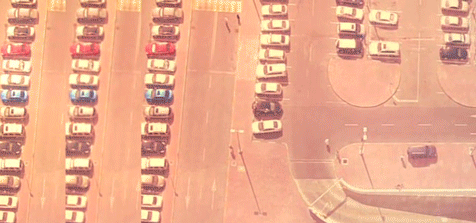ERC20-GIFs!

Excerpt of cars.gif by Jennifer & Kevin McCoy
(not monegraph signed)
On Friday May 2nd, around 7pm, Kevin McCoy completed transaction #1217706 on the Namecoin block chain. McCoy was taking part in Rhizome’s Seven on Seven, the fifth annual conference pairing up of artists and technologists at the New Museum. And that transaction through Namecoin, one of the countless spinoffs of Bitcoin, created an entry in a public ledger of exactly which bits are changing hands between two people.
But this transaction was different from the millions of other ledger entries tracked by Bitcoin and its variants.
This time, the bits being traded weren’t just tracking a virtual currency. Instead, they were tied to an original digital artwork created by established artists, becoming the first to follow a new convention called “monegraph”.
Until blockchain technology became available various efforts have been made to assert forms of provenance and verification for digital art , but most relied on the artworks to remain within closed, proprietary technological silos; few were designed to verify a work while also allowing it to be widely displayed across the Internet. As a result, the only way for artists to really build a market around their digital works has been to convert them into physical forms.
Historically, there has been anxiety about the fate of digital artists for at least as long as there has been digital art. But as most everyone’s computers got connected over the last two decades, the most fundamental cause of concern has been the effortlessness with which any given work can be instantly, and perfectly, copied. In a realm where novelty, rarity and exclusivity underpin so much of the (real or perceived) value of a work, copy and paste goes from being an act of creation to an act of destruction.
Reblogging is essential to getting the word out for many digital artists, but potentially devastating to the value of the very work it is promoting. What’s been missing, then, are the instruments that physical artists have used to invent value around their work for centuries — provenance and verification.
Provenance for an artwork can be asserted in countless ways, from witnessing performance art firsthand to having a world-famous auction house bet its credibility on whether a work is an original or not. This function is critical not just in enabling an economic art market, but also in the study and understanding of individual artworks and their context within a movement or culture.
Verification, on the other hand, takes on a new urgency in the digital realm. In this context, verification means the validation that a work is unchanged from its original form, and that the work in question is the actual work being discussed as a creation. It has, of course, always been possible to forge a work (and this is one of the issues meant to be solved in physical art by checking provenance), but there’s a more philosophical debate about verification in the digital realm, where simply viewing an image in a web browser results in a copy being made on the viewer’s computer or phone.
Various efforts have been made to assert forms of provenance and verification for digital art over the past few decades, but most relied on the artworks to remain within closed, proprietary technological silos; few were designed to verify a work while also allowing it to be widely displayed across the Internet. As a result, the only way for artists to really build a market around their digital works has been to convert them into physical forms.
Lemons